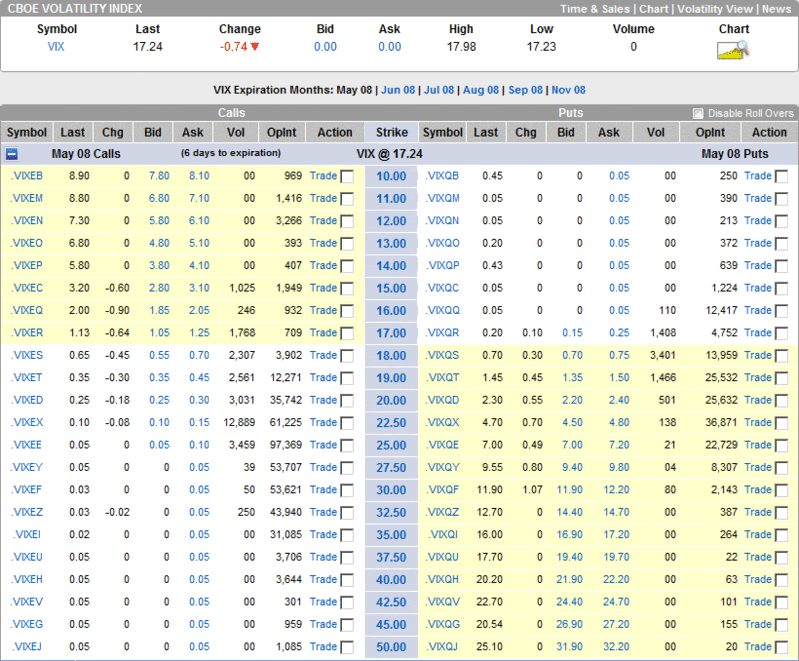VIX Options in Current Declining Volatility Environment
Kudos to Adam at Daily Options Report for today’s A Quick Trading VIX Primer, which provides a succinct explanation of the basis for VIX options prices – some of which have left casual options traders scratching their heads in recent days.
In Adam’s words:
“The VIX estimates volatility on the SPX itself for the next 30 days.
VIX futures are a bet on where that estimate will be on the day the future expires. In other words, it is a snapshot of what the market expects for volatility 30 days AFTER the future expires. If it is a September future for example, you are guessing how the market prices volatility 30 days forward from September expiration. You are not betting on SPX volatility between now and September; that is a common misconception.”
Two graphics might help to illustrate this point. The first graphic initially appeared on VIX and More one year ago in VIX Futures: The One Picture to Remember and shows what happened to the VIX futures on the day before and the day of the record 64% spike on the VIX on February 27th 2007. The bottom line is that the long-term outlook for volatility did not change appreciably, but the VIX futures moved from contango (upward sloping over time) to backwardation (downward sloping over time). So the future still looked the same, but the VIX was expected to take a different path to arrive at essentially the same place.

The second graphic is a snapshot of the VIX options as of this morning. Note that with the (cash/spot) VIX at 17.24, the bid on the May 17.00 puts (0.15) is almost the same as the bid on the May 22.50 calls (0.10). The reason? Mean reversion is priced into the VIX futures – and the options reflect the consensus opinion that a 5 point VIX spike is just about as likely as a 0.25 point drop in the VIX over the next week (recall that VIX options expire on Wednesdays; this month it is one week from today.)



3 comments:
Jim,
I don't want to be a "bean counter", but your statement
The second graphic is a snapshot of the VIX options as of this morning. Note that with the (cash/spot) VIX at 17.24, the bid on the May 17.00 puts (0.15) is almost the same as the bid on the May 22.50 calls (0.10). The reason? Mean reversion is priced into the VIX futures – and the options reflect the consensus opinion that a 5 point VIX spike is just about as likely as a 0.25 point drop in the VIX over the next week (recall that VIX options expire on Wednesdays; this month it is one week from today.)
may not be totally correct.
In fact VIX option prices may not reflect the consensus opinion that a 5 point VIX spike is just about as likely as a 0.25 point drop in the VIX over the next week, but in a perfect world the respective VIX option bid prices concerning the 17.00 and 22.50 strikes would reflect the option prices for which the following formula would apply:
Profit expectancy put option = SUM(probability of any possible VIX price below 17.00 -put strike- multiplied by the respective reward)
equals
Profit expectancy call option = SUM(probability of any possible VIX price above 22.50 -call strike- multiplied by the respective reward)
The respective reward depends on the price for the put and call option.
So a 5 point VIX spike may (or better: "will") not be quite as likely as a 0.25 point drop in the VIX. In fact the probability that the VIX put will settle in the money may be way higher than the probability that the VIX call will close in the money, but with respect to the respective profit expectancy the profit expectancy of the VIX call may (should) equal the reward of the respective put option even if the call option would need an at least 5 point spike in the VIX (especially with respect to the fact that there is -if any- a lognormal distribution in VIX price -limited to zero to the downside, but unlimited to the upside-).
Best regards
Frank
Frank,
You put it much better than my shorthand commentary did.
I would expand upon your view by adding that pushing the analytical domain out one strike farther says something about the expectation of the distribution of potential VIX moves. Specifically, there is no bid for a put at the 16.00 strike, yet there is bid of 0.05 for the 25.00 call.
It is fairly easy to visualize the anticipated future VIX values, with a positive skewness, as something like this.
By all means, it is important to count those beans...
Cheers,
-Bill
WOW just what I was looking for. Came here by searching for train
Feel free to surf to my website - diet that works
Post a Comment